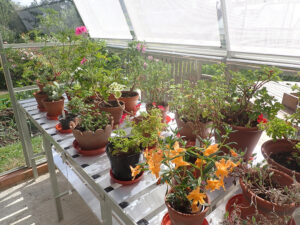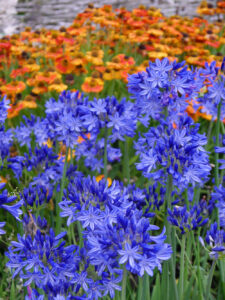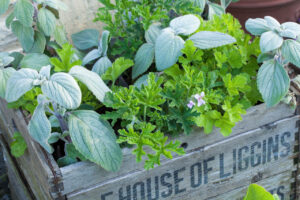I am delighted to say that I have a new Hartley Greenhouse, a Wisley Grow and Store, to play with. It joins an older Hartley Greenhouse that’s now twelve years old – but still as good as new. My new addition’s a gardener’s Greenhouse with full-length glass and staging and I’m going to grow seeds, raise cuttings and store tender plants.
When I ordered it, the chap told me I would get decades of use out of it. Well, I’m not too sure about that because I’m 73! I do know that my lovely Greenhouse will outlast me, unlike the wooden greenhouse I put up 20 years ago. That began to sag horribly, because it was under trees. Water kept dripping on to the timbers and it looked untidy. My wonderful new Hartley’s in a brighter spot, so I’ve had 3 blinds fitted to the southern side. I’ve also gone for a solid floor, because this is easier to maintain – although I’m not in my dotage just yet!

The storage area at the back will be as beautiful as I can make it. There’s staging on one side for propagating kit, but I’m also adding a small table, a chair and radio. And then I’m off, working in my phone-free retreat, sheltered from the brutal weather that Cold Aston tends to throw at us far too often. The clue’s in the village name. My potted, ‘tenderish’ plants will also enjoy beings shielded from the worst of the weather, for winter wet is a killer as last winter proved! If the roots are dry, most plants can survive cold temperatures. This is why hardiness is such a conundrum. It’s not just about temperature!
One of the most useful things about any greenhouse, even an unheated one, is it’s the ideal place to overwinter plants such as agapanthus, woody salvias and slightly tender grasses. I have two large pots, one containing Miscanthus nepalensis, and another planted up with a dark bottlebrush named Pennisetum alopecuroides ‘Black Beauty’. These come through winter in the borders. Sometimes surviving, sometimes not, so these are an insurance policy.
The way forward with your agapanthus pots is to begin to dry them out from the third week of September onwards. From then on potted-up agapanthus are on a health-farm diet, so no feeding is allowed either. Let the deciduous ones die down naturally and trim them off before the next year’s shoots break through. If the old foliage collides with the new shoots, it’s a fiddly time-consuming affair. It can take hours, as I know to my cost.

Favourite deciduous agapanthus varieties at Spring Cottage include Dick Fulcher’s ‘Northern Star’, raised on Dartmoor. This free-flowering, rich-blue agapanthus has dark shading at the base of the neat foliage and, I would say, it’s the best of the ten or so we grow in pots.
I’m also fond of the navy-blue ‘Alan Street’, but performance varies. It’s rather like my ‘Blenheim Orange’ apple tree. One good year is followed by a sabbatical year off. The stems of ‘Alan Street’ could be stronger too. Despite that, it’s still the best deciduous dark agapanthus on offer, because most of them are shy to flower. You only get one or two, at best.
‘Tarka’, also raised by Dick Fulcher’, is useful for two reasons. It’s mauve, rather than blue, and it flowers a few weeks later. It’s always good in September and garden visitors always admire it. Deciduous agapanthus varieties are definitely hardier than evergreen ones and they have neater foliage that dies down. Evergreen agapanthus have far wider leaves and they keep these in winter. The foliage is more intrusive. This year I grew the evergreen ‘Black Jack’, the winner of the RHS Chelsea Plant of the Year 2023. It didn’t flower this summer, but perhaps it will be my plant of the year in 2024.
The latest agapanthus of all is ‘Hole Park’ and this produces two enormous flower heads in September. This is sterile, so the flowers last and it’s often going strong (in the Greenhouse) in December. It’s accompanied by a near relative. A tulbaghia named ‘John May’s Special’. The smaller lilac-pink flowers begin in April and carry on until winter calls a halt. This is my best tulbaghia by far.
Potted agapanthus and tulbaghias are kept dry during winter, but they do need regular watering and feeding between May and the middle of September. Tomato food is fine for them. They are both thirsty plants and, should you be lucky enough to travel to South Africa, you will see them growing along the stream sides, along with kniphofias and crocosmias. All these plants like wet summers. Last year’s dry summer turned my crocosmias completely brown and I lost some of them during last winter.
Dieramas also like wet conditions, so don’t believe the television gardeners, when they tell you to starve your agapanthus. Lavish care and attention on them during the growing season. Every few years our agapanthus need dividing and the optimum time is spring. The deciduous ones make tough rootstocks and Steve and Elaine Hickman, along with their children Heather and Colin, run Hoyland Plant Centre. It’s the best place to acquire agapanthus, tulbaghias, nerines and dieramas and you may have seen their brilliant displays at the major RHS shows. Their website, www.somethingforthegarden.co.uk has a full mail order range.
The Hickmans use chain saws to cut their agapanthus up. I have a better strategy. As soon as the Best Beloved begins to tackle them, I go out, because it’s a chore just getting them out of the pot, let alone cutting them up!

Pelargoniums need very little heat to survive, so a frost-breaking heater is needed for them. They die in unheated greenhouses if the weather is iffy. My cuttings are taken at the end of summer and they get plunged into small seed trays filled with coarse, gritty sand. Fine sand is no good: it dries out. By early January they’ve normally rooted and, if the weather’s kind, they’re potted into 9cm pots.
There are lots of pelargoniums, but I prefer the scented leaved ones such as ‘Attar of Roses’, ‘Grey Lady Plymouth’ and ‘Royal Oak’. Their foliage blends together and I mix them with the larger-flowered ‘Clorinda’, a bright-pink unique, and ‘Copthorne’ – a softer pink.
My summer containers, planted into galvanised tubs, also contain plectranthus, but these soft-stemmed coleus-like foliage plants are not nearly as hardy as the pelargoniums. When I’m taking cuttings, I put the plectranthus cuttings in the middle of the tray and surround them with a protective barrier of pelargonium cuttings.
Plectranthus root easily and the silver-leafed P. argentatus is my choice plant for containers, although I do grow many others. The variegated ‘Ray Hubbard’ reminds me of the late Ray Hubbard of Hill House Nursery in Devon. He was a plantsman extraordinaire. It’s run by the next generation now. Check out the website – www.hillhousenursery.com
Hardy salvias, ones with small flowers and woody stems, come under three main names. Salvia microphylla, which is the hardiest and this generally has red or pink flowers – although not always! Salvia greggii is less hardy for me, but this has paler flowers typically in cream and peach. The natural hybrid between them is S. x jamensis, named after the Mexican village of Jame, in the Sierra Madre range. It was discovered and named by the British botanist James Compton in the early Nineties, in an area where the two parent species overlap.
If you want to keep heliotropes and fuchsias over winter you will need more heat and you’ll need to keep them in leaf, in my experience. I have electric Vitopod propagators and the bottom heat makes cuttings root more easily. You can do penstemons, rock roses, artemisias and a host of other things too. Once spring arrives, they are used to raise tomato, pepper and aubergine plants.
You can find out more about Vitopod propagators by Googling them! I’m off now – you’ll never guess where!











